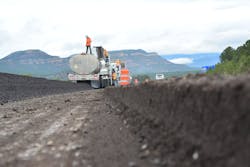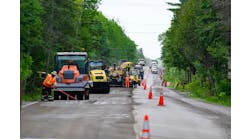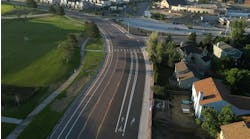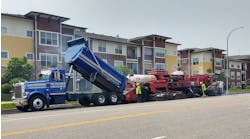The New Mexico Department of Transportation (NMDOT) needed work done on U.S. Route 550 and Interstate 25. Fisher Sand and Gravel – New Mexico, Inc. was hired for both projects, and their team used recycled materials to deliver for each road.
This year, the Asphalt Recovery and Reclaiming Association (ARRA) awarded both projects. The U.S. 550 project won ARRA’s Full Depth Reclamation (FDR) award, and the I-25 project won ARRA’s Cold In-Place Recycling (CIR) award.
Known for its support for innovative solutions, NMDOT previously hired Fisher Sand and Gravel on similar road projects. The team had the experience to complete the projects in a short amount of time, and with the right tools.
Frank Lozano, the project manager, oversaw the success of US 550 and I-25. He works at Fisher Sand and Gravel – New Mexico, Inc., the sister company to Fisher Sand & Gravel Co.
Lozano said that Fisher has a history of attempting new processes proposed by NMDOT. “We are very happy to be recognized for being successful in these endeavors,” he said.
Beginning in May 2023, the U.S. 550 project is one of the first emulsion FDR projects that was completed in New Mexico. Previously, NMDOT did not allow emulsion on FDR projects. Costing close to $13 million, the project used 100% Reclaimed Asphalt Pavement (RAP).
“The U.S. 550 project in San Mateo, County, New Mexico is a textbook example of how full depth reclamation can save on time and costs compared to remove and replace pavement reconstruction options,” said ARRA President Jason Wielinski. “Through communication, engineering and planning, the New Mexico DOT and the contractor were able to formulate a solution using FDR that solves the encountered pavement distress issues more effectively than the original mill and fill plan.”
This was Fisher Sand and Gravel’s first attempt at performing the reclaiming process themselves, leading the crew to learn how to operate new, upgraded equipment in a short time frame. They learned how to operate the new equipment and delivered the result in six months.
Fisher Sand and Gravel had to upgrade their reclaimer to include a pump and metering package to handle the addition of the emulsion. They also had to purchase equipment to spread the cement. The company’s operation’s team was on the job, researching and collecting the necessary equipment to get the job done.
"The procurement of all the required equipment, while still meeting the project schedule was a challenge,” Lozano said.
The original plan was for the project to be a mill and fill. However, after evaluating the pavement, the project team saw too many areas that needed to be rebuilt. So, they opted to use FDR for the entire project. Hot-Mix Asphalt (HMA) SP-IV and Open Graded Friction Course were placed on top of the FDR, finishing the project in November of 2023.
U.S. 550 sees approximately 131,000 equivalent single axle loads (ESAL) yearly, with 13% being heavy commercial traffic.
While U.S. 550 sees a great deal of traffic, I-25 sees approximately 829,000 ESAL’s a year, with 19% being heavy commercial traffic.
Beginning last August and costing a little over $15 million, the I-25 project used 100% CIR. The team, consisting of Fisher Sand and Gravel and Coughlin Company, came up with a plan to recycle the shoulders and both driving lanes with a single joint between two laydown passes. That created milling and laydown widths to maximize the equipment’s capabilities.
Coughlin Company performed the CIR process, while Fisher Sand and Gravel handled the laydown, compaction, and quality control. This was the third CIR project done by NMDOT in 10 years.
However, this project was different than previous projects due to its geography. It was completed at a higher elevation and cooler climate.
As crews worked on the project, rain and snow became an issue during construction. The precipitation introduced the potential for moisture and freeze-thaw damage. The road had to fully cure in the colder temperatures, leading to lanes being closed so traffic wouldn’t drive over it.
Dealing with the elements was not the only challenge on the I-25 project. Being on an interstate as opposed to a rural roadway with lower traffic counts was a hurdle the team had to overcome. This led to lane closures and congestion.
RAP windrow placement from the milling and sizing units were necessary to ensure the laydown machine’s elevator was able to pick up the RAP from the windrow to properly feed the laydown hop mixer.
The CIR was overlayed with SP-III Warm Mix Asphalt (WMA) and a WMA Open Graded Friction Course. This combination reduced greenhouse gas for NMDOT.
I-25 had over 18,000 feet of guard rail that needed to be installed. The result: closed lanes and traffic on the CIR for over 30 days. Since Coughlin Company provided a uniform recycled material, the team was able to place and compact durable CIR material with no issues as traffic traversed the interstate.
Shawn Hammer, the quality control manager at Fisher Sand and Gravel, said that he wishes all the CIR the team placed was smooth.
“The reality is, there were some areas that were rough enough that a single lift WMA overlay would not have taken care of the ride issues,” he said. They had a solution, however. “Fisher Sand and Gravels’ superintendent did a fantastic job of ‘micro-milling’ with our regular mill in those areas and removed the roughness that could have created problems with the final ride of the project.”
NMDOT estimates that using CIR on this project compared to the mill and fill saved $1.6 million. Not only did it cut costs, but it also performed well under interstate traffic.
“The CIR process as a whole is a very environmentally sound solution that offers dramatic reduction in emission and energy consumption when compared to traditional paving solutions,” said John Morgan, the market development manager at Ingevity who worked with the project.
The team finished the I-25 project in three months.
ARRA’s awards to NMDOT for these projects are well deserved. The team showed that the innovative solutions to New Mexico’s road projects were worth it in the end. Not only do they cut down on costs and greenhouse gas emissions, but applying the proper tools can make any project better for the road user in the end. RB



